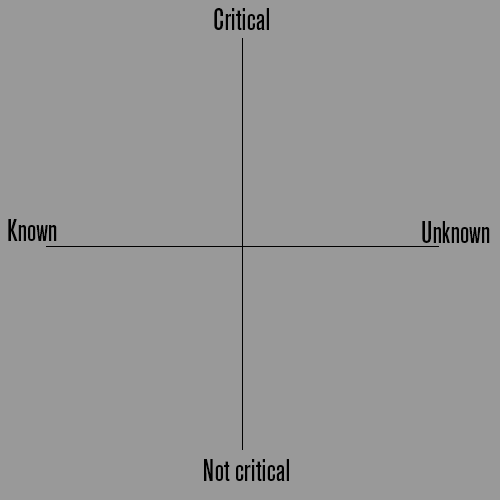Three Organizational Tools Your Organization Should Be Using
Design Thinking is a great way to get your organization focused-here are three Design Thinking tools that you could put into practice today.

Need/Know Matrix

Last time I wrote, I focused on Design Thinking and why it’s important for those of us in healthcare to understand and adopt it as a way of doing business. What I didn’t get a chance to highlight in detail is how incredibly practical Design Thinking is and the plethora of tools available that should make it into your regular repertoire-and I’m not just talking about markers and sticky notes!
I have a lot of tools I love using, but since I’m limited on words here I’ll focus on three of my favorites and how to use them. While these are often used during a particular stage of the process, there are no rules about when you use them other than when it feels right or when doing so will solve a need.
1. 20 Questions
This tool is just what it sounds like-asking questions and getting answers that can provide a foundation for the project. It’s also a great way to challenge assumptions in the middle of a project, to force a team to step back and reset, or to help get unstuck.
To use 20 Questions all you need to do is get the key players into a room and give them sticky notes and markers (yes, we really do use markers and sticky notes!). Everyone gets three minutes to write down questions-and only questions-about the project, one question per sticky note. At the end of those three minutes, a facilitator collects the questions and you spend time walking through them as a group. When appropriate, you can get the project sponsor in the room to provide some answers.
We often ask questions like: what’s been tried before, why is this important to the organization, and what does success look like. In his new book Questions Are the Answer, Hal Gregersen, executive director of the MIT Leadership Center, provides great insight on why asking questions is the best thing you can do. We agree!
2. Related worlds
This is a favorite because it forces us out of our own world view and gets us inspired by what others are doing. Here’s how it works: you start by thinking about the basis or core of your challenge and then move into thinking about players completely outside of your industry who are doing that core thing really well. After dissecting why they’re so good at it and how they do it, you think about how you might apply those same principles back to your challenge.
So if you’re thinking about customer loyalty, it might be a good idea to visit a place like Lululemon-where they have a cult following-and read articles on how they do it.
Related article: Five Small Workspace Changes Health Execs Can Make to Foster Innovation
If you’re thinking about customer experience, like so many of us are right now, you can’t not think about The Ritz-Carlton. How does The Ritz-Carlton make each encounter special? Well, for one, they keep a file of what you like, so when you arrive they can have your favorite M&Ms in your room. Knowing and storing patient or member preferences? Yeah, we could do that.
One of my favorite examples of this is when we were building our new customer experience center, Independence LIVE, our chief marketing officer knew we needed someone special to run it. She wanted someone who would inspire the right attitude, who would keep the people working on the floor motivated, and who could stay on top of the various missions of the space. Who did she hire? A former basketball coach. Because when she looked at what she needed, the core of it was a coach. Her instinct was right on!
3. Need/Know Matrix
This one has a special place in my heart. The Need/Know Matrix helps identify the assumptions you have about an idea and shakes out which of those assumptions are critical to success and need to be tested.
Start with a matrix that has “critical” at the top of the Y axis and “not critical” at the bottom. This is to indicate how important a particular assumption is to your idea-critical means if your assumption is wrong, your idea is dead. Not critical means it may limit the idea, but you can work around it or change the idea. The X axis has “known” on the left and “unknown” on the right. Known means you can access and find information about this assumption fairly easily. Unknown means you would have to create an experiment to find out.
Next, write out all of your assumptions about the idea, one per sticky note. Assumptions can be hard to come up with, but there are always more than you realize! Usually the very first assumption is, “people want this.”
Once everyone has their assumptions written out, map them on the matrix by asking the following: is this critical to my idea, if I’m wrong will it fall apart, and do I know this or is it an unknown. Once the sticky notes are placed in their appropriate quadrants, you’ll want to pay attention to the critical unknowns-the top right quadrant.
A “critical unknown” signals you need to run some tests or experiments before moving forward to prove those assumptions.
Related article: Four Ways to Spur Innovation at Your Managed Care Organization
We can look to Zappos for a great example of how to use this tool. When Nick Swinmurn, founder of Zappos, had the idea for the online store it was before people were buying shoes on the internet (yes, there was such a time). He had one major assumption: that people would buy shoes, sight unseen. Other assumptions included that there are enough annual shoes sales to sustain business, that people would buy men’s, women’s and children’s shoes online, and that people would pay for shipping. We can map these assumptions to see how this tool works.
The first assumption-people would buy shoes online, was the crux of his idea. It was absolutely critical that this assumption was true, and also absolutely unknown. The assumption that there are enough annual shoes sales to sustain the business was also critical-but known, because information about overall shoes sales could be determined with basic research. The thought that people would buy all types of shoes-men’s, women’s and children’s-was not as critical. If this wasn’t true, via research Nick could determine which type of shoes would sell most (and we’ll take a guess that it would be women’s!). And finally, the assumption about shipping was unknown, but would not be critical to the success of the idea. If people would not pay for shipping, shipping cost could be “baked into” the price and offered at no charge.
You’ve maybe heard the story of how Nick ran his test to prove out his critical unknown. He went to his local mall and took pictures of the shoes, which he then posted online. When someone wanted to buy a pair, he went back to the store and purchased them and sent them out. He was able to test that critical assumption without having any inventory of his own-very low risk.
I hope you’ll get to try some of these tools in the next several weeks. These are just a few that will sell you on the need for Design Thinking in your organization.
Michelle Histand is an innovation director at Independence Blue Cross, where she has fostered and advanced the organization’s design thinking approach to problem solving.
Phase 3 Trial of Vertex’s Islet Cell Therapy for Type 1 Diabetes in Under Way
April 23rd 2025Zimislecel is an allogeneic stem cell-derived islet cell therapy that could eliminate the need for insulin in those who have type 1 diabetes. Regulatory submissions are expected in 2026, and if approved, would be the second cell therapy for type 1 diabetes.
Read More
Conversations With Perry and Friends
April 14th 2025Perry Cohen, Pharm.D., a longtime member of the Managed Healthcare Executive editorial advisory board, is host of the Conversations with Perry and Friends podcast. His guest this episode is John Baackes, the former CEO of L.A. Care Health Plan.
Listen
Breaking Down Health Plans, HSAs, AI With Paul Fronstin of EBRI
November 19th 2024Featured in this latest episode of Tuning In to the C-Suite podcast is Paul Fronstin, director of health benefits research at EBRI, who shed light on the evolving landscape of health benefits with editors of Managed Healthcare Executive.
Listen
Experts Explore Causes and Care for Chronic Itch
April 22nd 2025In a recent discussion with Managed Healthcare Executive, three leading dermatologists and itch experts—Shawn Kwatra, M.D., Brian Kim, M.D., and Gil Yosipovitch, M.D.—shared where the science is going, what’s holding it back and how the healthcare system can better support patients.
Read More